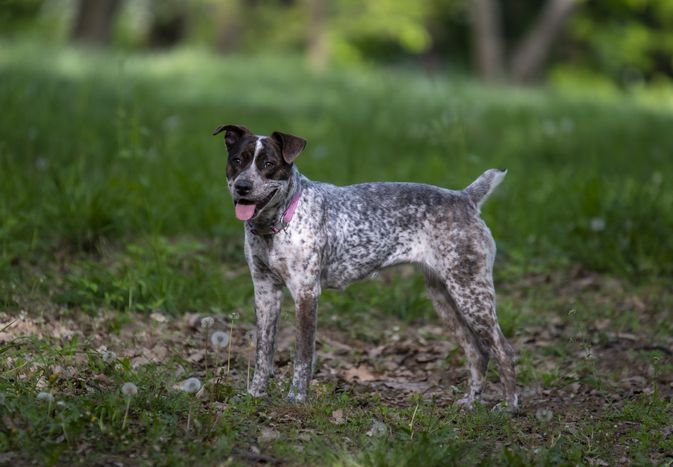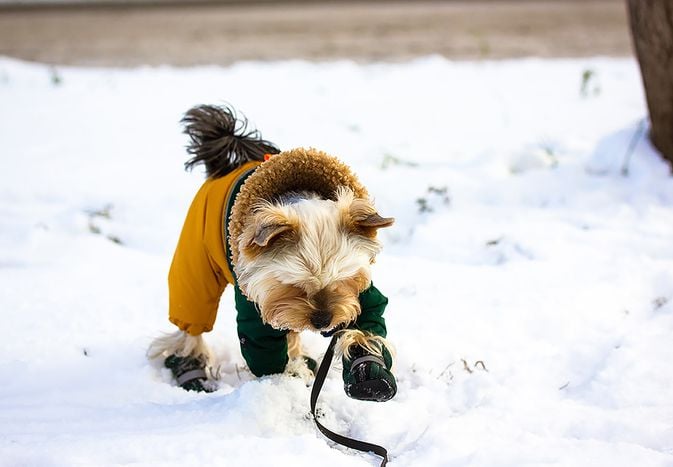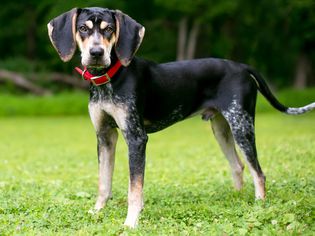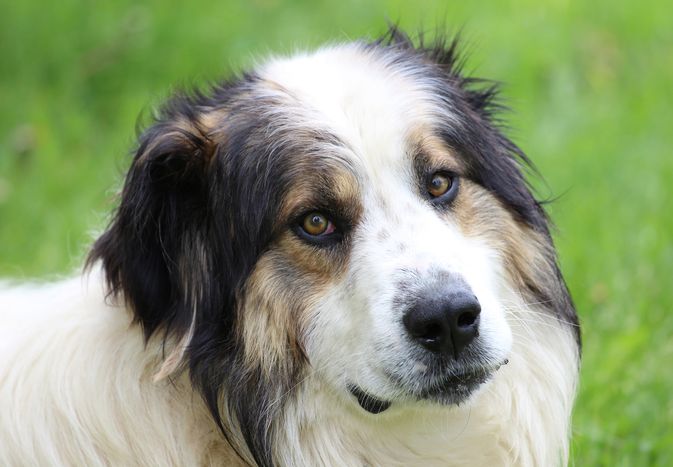Known for their distinctive blue-tinged coats, the Texas heeler is an energetic and intelligent working breed. These dogs are a mix between an Australian shepherd and an Australian cattle dog and boast characteristics from both these "parent" breeds.
Named for the state where they’re most likely to be found, the breed earned its “heeler” nickname from the Australian cattle dog because they are often referred to as the Queensland heeler or blue heeler. A great option for active owners, Texas heelers are highly intelligent and will be happiest when they have a job to do, which is why they excel in games and canine sports. They make for loyal and devoted family companions and will do well in families with children and similar-sized pets if socialized from a young age.
Learn about the Texas heeler’s history, care needs, temperament, and more.
Breed Overview
Group: Working
Height: 17 to 22 inches
Weight: 25 to 50 pounds
Coat: Short to medium length; smooth and soft
Coat Color: Black, blue merle, or blue ticked, with the possibility for white or tan trim on feet and legs
Life Span: 12 to 15 years
Temperament: Intelligent, loyal, bold, active, playful, bright, fearless
Hypoallergenic: No
Origin: United States
Characteristics of the Texas Heeler
If you're looking for a dog that can keep pace with your active and full lifestyle, a Texas heeler may be a great choice. Bred from two highly intelligent and active "parent" breeds, the Texas heeler excels at being put to work or just hitting the great outdoors with their family.
If left unchecked, a Texas heeler's headstrong nature can make them difficult to train, so it's important to implement skills and command authority from the get-go with this breed. The more mentally stimulated and physically active a Texas heeler is, the more likely they are to consistently behave themselves.
Also, these dogs are loyal to their families, but they may be wary around strangers.
| Affection Level | High |
| Friendliness | Medium |
| Kid-Friendly | Medium |
| Pet-Friendly | Medium |
| Exercise Needs | High |
| Playfulness | High |
| Energy Level | High |
| Trainability | High |
| Intelligence | High |
| Tendency to Bark | Medium |
| Amount of Shedding | Medium |
History of the Texas Heeler
The Texas heeler is a “designer dog” created by breeding two purebreds. In May of 1970, Lucy Guynes registered the Texas Heeler with the Animal Research Foundation and the breed’s popularity quickly grew as a working dog for farms and ranches in Texas.
The story of this breed’s origins is somewhat unique when compared to many other designer breeds. To truly understand the Texas heeler, you have to take a look at the characteristics of both the Australian cattle dog and the Australian shepherd dog. Because there isn’t a great deal of information on the exact origins of the Texas heeler, an exploration of the history of the parent breeds can help you understand this lovable companion and working dog.
In the 1800s, Australian settlers on large ranches bred the Australian cattle dog as a hardy working dog that could help herd cattle; they needed a breed that could tolerate the often challenging climate in Australia, and dogs that had previously been imported from England weren’t able to withstand the challenging ranch life.
Ranchers began breeding English dogs with the native dingo of Australia, and most of these dogs ended up with a distinctive blue-colored coat, earning them the name blue heelers. In 1893, Robert Kaleski began breeding blue heelers, and the dog was accepted into the American Kennel Club in 1980.
Texas Heeler Care
Texas heelers can be great family pets, but early (and frequent) training is necessary to ensure you channel their intelligence and energy properly. Because they are an active breed, they do best in a home that boasts plenty of land and access to activities such as hiking or dog parks. With the proper care and attention, they can be a loyal companion for years to come.
Exercise
Texas heelers are bred from two very active herding breeds, so they'll require lots of daily exercise. As working dogs, they also prefer having a job to do and are highly task-oriented.
When they aren’t given the physical stimulation they need, Texas heelers can exhibit destructive behaviors like chewing and barking, and may also experience separation anxiety.
They make excellent running and cycling companions but will also thrive with a variety of activities that condition them physically and stimulate them mentally, like:
- Hide-and-seek
- Fetch
- Canine sports
- Agility
- Obedience training
They do have an innate drive to herd, so be sure to walk your dog on a leash and keep them close when out and about.
Warning
Texas heelers are prone to hyperthermia on hot days when they exercise. They will continue to play even when they are overheated. Take care to ensure they stay cool, remain properly hydrated, and don’t overexert themselves.
Grooming
Though Texas heelers only have short- to medium-length coats, they are thick and double-layered, so they tend to shed moderately most of the time. When they blow their undercoats in the spring shedding season (and sometimes even in the fall), the shedding can become heavier.
You'll want to brush out your Texas heeler's coat at least once or twice weekly with either a bristle or pin brush to help keep their coats as healthy as possible and minimize excessive shedding.
Additionally, maintain a regular grooming routine when it comes to teeth brushing, ear cleaning, and nail trims. If you feel at all unable to complete these tasks every few weeks, you can look into groomers in your area to do it for you.
Also, because this breed is prone to eye problems, check your dog’s eyes often for symptoms that would indicate a need to see the vet, such as cloudiness, irritation, and redness.
Training
Texas heelers are a highly intelligent breed, making them relatively easy to train. Though they are very affectionate with their families, they can be protective and suspicious of strangers. As a result, they are popular watchdogs (though they often won't bark unless a stranger is actually spotted).
They can also be great with kids but may need to be disciplined not to nip and herd from time to time. If you have other pets in your home, it's helpful to raise your dog from a young age alongside them—otherwise, they may be inclined to utilize their natural herding instinct on the other fur members of the household, especially if they are smaller in size.
Common Health Problems
Though they are generally healthy, Texas heelers can develop a few health issues that you should be aware of. If you notice symptoms of the below issues—or any health problems at all—make sure to contact your vet promptly.
Some health issues common with Texas heelers include:
- Hip and/or elbow dysplasia: These orthopedic conditions cause abnormal development of the hips or elbows. As a result, the joints aren’t stable and don’t function properly.
- Distichiasis: This is a condition where eyelashes grow on the inside of the eyelid.
- Eye problems: This breed can develop various eye issues, such as hereditary cataracts, primary lens luxation, iris coloboma, and progressive retinal atrophy, which is a serious and incurable condition that can eventually cause blindness.
- Deafness: Because blue heelers are at risk of being deaf, Texas heelers can be too. Symptoms include jumpiness and lack of response to sounds.
- Multidrug sensitivity: Also known as MDR1, this inherited condition causes dogs to be more sensitive to certain drugs, so veterinarians need to prescribe medications carefully to avoid serious neurological effects.
Diet and Nutrition
Texas heelers can be prone to easy weight gain, especially if they're not active enough, so ensure that your dog is receiving a biologically appropriate food containing both protein and healthy fats.
You'll also want to look for formulas with ground bone and vegetables in them, as they contain vitamins and minerals that are essential for this breed's optimal health and performance.
Talk to your vet about the amount of food to feed your dog, as well as how often to feed them. It’s best to feed them smaller meals multiple times a day, such as twice a day.
Where to Adopt or Buy a Texas Heeler
In general, you can expect to pay anywhere from $500 to $1,000 for a Texas heeler puppy from a breeder.
The Texas heeler technically falls under the category of a "designer breed,” which means you’ll likely have to work with a breeder in order to take one of these dogs home. Always do your best to seek out a reputable breeder before purchasing—they should be able to provide you with health and vaccination records for both parents and have a track record of healthy litters.
Just like any other mixed breed dog, they can sometimes end up in shelters as well as breed-specific rescues, such as the Texas Cattle Dog Rescue.
Texas Heeler Overview
The Texas heeler is a great dog that can make a fun family pet. They do require a lot of attention and exercise, but they are smart, playful, and highly trainable. Plus, they make loyal and protective companions.
Pros of Texas Heelers
- Great family pet
- Easily trainable
- Hard-working
- Very intelligent
Cons of Texas Heelers
- Require lots of daily exercise and mental stimulation
- Can be wary of strangers
- Can get destructive if left alone too long
- Strong herding instincts

More Dog Breeds and Further Research
When determining if the Texas heeler is the right dog for your family, be sure to research all aspects of the breed and consult other Texas heeler dog parents, as well as breeders and rescue groups, to learn more.
If you're interested in similar breeds, check out:
- Blue Lacy
- Kerry Blue Terrier
- Lancashire Heeler
There's a whole world of potential dog breeds out there—with a little research, you can find the right one to bring home!
- Is a Texas heeler a good family dog?
Texas heelers can make good family pets for those that are active and have the time and energy to devote to this active and playful breed. However, they might nip at kids and chase small pets, thanks to their natural herding instinct.
Are Texas heelers good apartment dogs?No—Texas heelers are very active dogs that need a lot of physical and mental stimulation. They do best in homes with ample backyard space for them to play in. If you do live in an apartment, take your Texas heeler for frequent walks and trips to the dog park to ensure they get enough exercise.
Are Texas heelers aggressive?Texas heelers are not considered an innately aggressive dog breed. However, they can be skeptical of new people and may bark or keep their distance until they're comfortable. They also have a natural herding instinct, so they may try to corral small children or pets, even gently nipping at them to "keep them in line."
What's the difference between a blue heeler and a Texas heeler?Blue heelers and Texas heelers are not the same breed, but they are related. Texas heelers are the result of crossing the Australian cattle dog, also known as the blue heeler, with the Australian shepherd.
Is the Texas heeler a recognized breed?No, the Texas heeler is not recognized by any major kennel clubs such as AKC, CKC, and UKC. However, the Texas heeler's parent breeds, the Australian cattle dog and Australian shepherd, are each recognized in the herding/pastoral groups.
More like this








